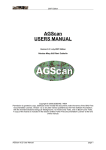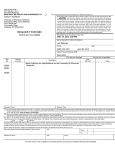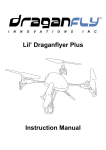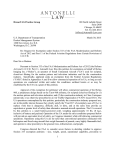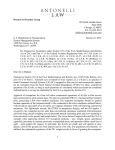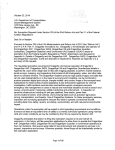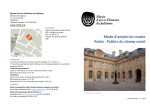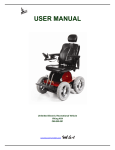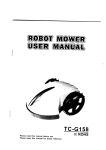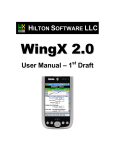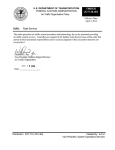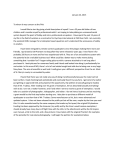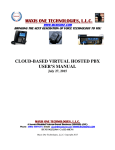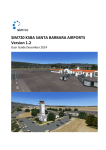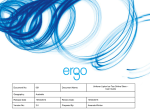Download AgScan,_Inc - Drone Laws Blog by Antonelli Law
Transcript
UNITED STATES OF AMERICA DEPARTMENT OF TRANSPORTATION FEDERAL AVIATION ADMINISTRATION WASHINGTON, DC Regulatory Docket No. _______________ IN THE MATTER OF THE PETITION FOR EXEMPTION OF: AGSCAN, INC. FOR AN EXEMPTION SEEKING RELIEF FROM THE REQUIREMENTS OF TITLE 14 OF THE CODE OF FEDERAL REGULATIONS SECTIONS 61.113(a) & (b), 91.7(a), 91.121, 91.151(b), 91.405(a), 91.407(a)(1), 91.409(a)(1) & (a)(2), AND 91.417(a) & (b) CONCERNING COMMERCIAL OPERATION OF THE DRAGANFLYER X4-ES UNMANNED AIRCRAFT SYSTEM PURSUANT TO SECTION 333 OF THE FAA MODERNIZATION AND REFORM ACT OF 2012 (PUBLIC LAW 112-95) Submitted on January 23, 2015 GREGORY S. WINTON, ESQ. JARED M. ALLEN, ESQ. THE AVIATION LAW FIRM 1997 Annapolis Exchange Parkway Suite 300 Annapolis, Maryland 21401 Tel: (301) 294-8550 Fax: (866) 568-9886 Attorneys for Petitioner TABLE OF CONTENTS Page GLOSSARY OF ABBREVIATIONS .................................................................................3 SUMMARY .........................................................................................................................4 INTRODUCTION AND INTERESTS OF PETITIONER .................................................4 BACKGROUND .................................................................................................................5 BASIS FOR PETITION ......................................................................................................5 NAME AND ADDRESS OF PETITIONER .................................................................7 THE SPECIFIC SECTIONS OF 14 C.F.R. FROM WHICH AGSCAN, INC. SEEKS EXEMPTION ................................................................................................................8 THE EXTENT OF RELIEF AGSCAN, INC. SEEKS AND THE REASON AGSCAN, INC. SEEKS THE RELIEF .......................................................................11 THE REASONS WHY GRANTING AGSCAN, INC.'S REQUEST FOR EXEMPTION WOULD BE IN THE PUBLIC INTEREST .......................................14 THE REASONS WHY GRANTING THE EXEMPTION WOULD NOT ADVERSELY AFFECT SAFETY ..............................................................................19 SUMMARY THAT CAN BE PUBLISHED IN THE FEDERAL REGISTER..........33 ANY ADDITIONAL INFORMATION, VIEWS, OR ARGUMENTS AVAILABLE TO SUPPORT AGSCAN, INC.'S REQUEST ............................................................33 CONCLUSION .................................................................................................................33 2 GLOSSARY OF ABBREVIATIONS AGL Above Ground Level AOI Area of Interest ATC Air Traffic Control ATO Air Traffic Organization C.F.R. Code of Federal Regulations COA Certificate of Authorization FAA Federal Aviation Administration FAR Federal Aviation Regulations GCS Ground Control Station GPS Global Positioning System LOL Loss of Link NAS National Airspace System NOTAM Notice to Airman PIC Pilot In Command RTH Return To Home Section 333 FAA Modernization and Reform Act of 2012 (FMRA) Section 333 SOP Standard Operating Procedures UA Unmanned Aircraft UAS Unmanned Aircraft System VFR Visual Flight Rules VLOS Visual Line of Site VMC Visual Meteorological Conditions VO Visual Observer VTOL Vertical Takeoff and Landing 3 SUMMARY AgScan, Inc. seeks exemption from the requirements of 14 C.F.R §§ 61.113(a) & (b), 91.7(a), 91.121, 91.151(b), 91.405(a), 91.407(a)(1), 91.409(a)(1) & (a)(2), and 91.417(a) & (b), to commercially operate an Unmanned Aircraft System pursuant to Section 333 of the FAA Modernization and Reform Act of 2012 (FMRA). This exemption will permit AgScan, Inc. to operate an Unmanned Aircraft System (UAS) for the commercial purpose of conducting aerial acquisitions and research over certain rural areas of the United States. INTRODUCTION AND INTERESTS OF THE PETITIONER AgScan, Inc. (hereinafter referred to as “AgScan”) was founded in 2014 by CEO Joshua Brown, a U.S. Navy veteran, certified UAS pilot, published UAS researcher, and search and rescue expert. AgScan is a Service-Disabled Veteran-Owned Small Business (SDVOSB) focused on bringing the technological advancements of UAS into the foreground of precision agriculture. This innovative approach to data collection will ultimately enable multiple industries to have a faster, safer, and more efficient way to do business. AgScan offers comprehensive program management solutions to develop data, with precision and speed, concerning precision agriculture, land management, infrastructure, and architecture. AgScan is fully compliant with government regulations and industry protocols. AgScan firmly believes in combining innovation, integrity, and quality into all of its operations, in order to best aid its clients and the communities it serves. As set forth in this Petition, AgScan seeks to commercially operate its Draganflyer X4ES UAS over certain rural areas of the United States for the purpose of conducting aerial acquisitions and research, remote gathering of agricultural data, infrastructure management 4 assessments, search and rescue operations, and reconnaissance in support of disaster or emergency situations. BACKGROUND Unmanned Aircraft System: Draganflyer X4-ES UAS AgScan seeks an exemption to operate the AgScan Draganflyer X4-ES UAS for compensation or hire within the NAS. The Draganflyer X4-ES UAS is comprised of a vertical takeoff and landing (VTOL) Unmanned Aircraft (UA) and a transportable Ground Control Station (GCS). The Draganflyer X4-ES UA has a maximum gross weight of approximately 5.5 pounds, while having a diameter of 42 inches, height of 11.5 inches, and maximum speed of 30 mph (approximately 26 knots). The Draganflyer X4-ES UA is equipped with four propellers, each being driven by a Lithium Polymer battery powered electric motor. The Draganflyer X4-ES UA that will be operated by AgScan will be registered in accordance with 49 U.S.C. 44103, Registration of Aircraft, as well as 14 C.F.R Part 47, Aircraft Registration, and marked in accordance with 14 C.F.R. Part 45, Identification and Registration Marking. BASIS FOR PETITION Petitioner, AgScan, Inc., by and through undersigned counsel, pursuant to the provisions of the Federal Aviation Regulations (14 C.F.R. § 11.61) and the FAA Modernization and Reform Act of 2012, Section 333, entitled Special Rules for Certain Unmanned Aircraft Systems, hereby petitions the Administrator to operate the Draganflyer X4-ES UAS in the National Airspace System (NAS), and for an exemption from the requirements of 14 C.F.R §§ 61.113(a) & (b), 91.7(a), 91.121, 91.151(b), 91.405(a), 91.407(a)(1), 91.409(a)(1) & (a)(2), and 91.417(a) & (b). 5 In consideration of the size, weight and speed, as well as the limited area of intended operation associated with the unmanned aircraft, AgScan’s use of the Draganflyer X4-ES UAS meets the conditions of the FMRA Section 333 and therefore, will not require an airworthiness certificate in accordance with 14 C.F.R. Part 21, Subpart H. Accordingly, AgScan requests relief from Sections 91.405(a), 91.407(a)(1), 91.409(a)(1) & (a)(2), and 91.417(a) & (b), as these sections set forth requirements for maintenance that only apply to aircraft with an airworthiness certificate. AgScan submits that the requested relief is proper since an equivalent level of safety will be ensured. AgScan will use manufacturer trained technicians to perform maintenance, alterations, or preventive maintenance on the UAS using the methods, techniques, and practices prescribed in the manufacturer’s maintenance manual. Furthermore, AgScan will document and maintain all maintenance records for the Draganflyer X4-ES UAS. Relief from certain requirements of Section 61.113(a) and (b), entitled Private pilot privileges and limitations: Pilot in command, is requested by AgScan to the extent necessary to allow a Pilot in Command (PIC) holding a private or higher level pilot certificate, and an airman medical certificate, and who has completed the Draganflyer X4-ES UAS training and currency requirements, to conduct the proposed UAS flight operations for compensation or hire. AgScan submits that the conditions and limitations set forth herein will ensure the safety of the NAS, as well as the safety of persons and property on the ground. AgScan seeks relief from Section 91.7(a), entitled Civil aircraft airworthiness, because the Draganflyer X4-ES UAS does not require an airworthiness certificate in accordance with 14 C.F.R. Part 21, Subpart H. As such, AgScan submits that it will ensure that the Draganflyer X4ES UAS is in an airworthy condition prior to every flight, by determining that the UAS is in 6 compliance with its type design pursuant to the Draganflyer X4-ES User Manual, and that the aircraft is in a condition for safe flight. AgScan also seeks an exemption from the requirements of Section 91.121, entitled Altimeter Settings, as the Draganflyer X4-ES UA will not have a typical barometric altimeter onboard. However, altitude information of the Draganflyer X4-ES UA will be provided to the PIC via Global Positioning System (GPS) equipment and a radio communications telemetry data link, which downlinks from the UA to the GCS for active monitoring of the flight path. This altitude information, combined with AgScan’s operation of the Draganflyer X4-ES UA within visual line of sight, at or below 400 feet AGL, will ensure a level of safety equivalent to Section 91.121. Additionally, AgScan seeks an exemption from the requirements of Section 91.151(b), entitled Fuel requirements for flight in VFR conditions. AgScan submits that safety will not be affected by operation of the Draganflyer X4-ES UA during daylight hours under visual flight rules (VFR) and visual meteorological conditions (VMC), with enough battery power to fly for a total duration of 15 minutes to the first point of intended landing and, assuming normal cruising speed, to fly after that for at least five minutes (i.e., 25 percent battery power remaining). In accordance with 14 C.F.R. § 11.81, AgScan provides the following information in support of its petition for exemption: A. Name And Address Of The Petitioner. The name and address of the Petitioner is: AgScan, Inc. 108 Sharlow Drive Wallingford, PA 19086-6634 7 The point of contact for this Petition and specific contact information is as follows: Gregory S. Winton, Esq. The Aviation Law Firm 1997 Annapolis Exchange Parkway, Suite 300 Annapolis, Maryland 21401 Tel: (301) 294-8550 | Fax: (866) 568-9886 Email: [email protected] B. The Specific Sections Of 14 C.F.R. From Which AgScan Seeks Exemption. 1. AgScan Seeks Exemption From The Requirements Of Section 61.113(a) And (b). Section 61.113, entitled Private pilot privileges and limitations: Pilot in command, subsections (a) and (b) prescribe the following, in relevant part: (a) No person who holds a private pilot certificate may act as a pilot in command (PIC) of an aircraft that is carrying passengers or property for compensation or hire; nor may that person, for compensation or hire, act as PIC of an aircraft. (b) A private pilot may, for compensation or hire, act as PIC of an aircraft in connection with any business or employment if— (1) The flight is only incidental to that business or employment; and (2) The aircraft does not carry passengers or property for compensation or hire. 2. AgScan Seeks Exemption From The Requirements Of Section 91.7(a). Section 91.7, entitled Civil aircraft airworthiness, subsection (a), states the following: (a) No person may operate a civil aircraft unless it is in an airworthy condition. 3. AgScan Seeks Exemption From The Requirements Of Section 91.121. Section 91.121, entitled Altimeter settings, subsection (a), states the following, in part: (a) Each person operating an aircraft shall maintain the cruising altitude or flight level of that aircraft, as the case may be, by reference to an altimeter that is set, when operating-(1) Below 18,000 feet MSL, to-(i) The current reported altimeter setting of a station along the route and within 100 nautical miles of the aircraft; 8 (ii) If there is no station within the area prescribed in paragraph (a)(1)(i) of this section, the current reported altimeter setting of an appropriate available station; or (iii) In the case of an aircraft not equipped with a radio, the elevation of the departure airport or an appropriate altimeter setting available before departure. 4. AgScan Seeks Exemption From The Requirements Of Section 91.151(b). Section 91.151, entitled Fuel requirements for flight in VFR conditions, subsection (b), states the following: (b) No person may begin a flight in a rotorcraft under VFR conditions unless (considering wind and forecast weather conditions) there is enough fuel to fly to the first point of intended landing and, assuming normal cruising speed, to fly after that for at least 20 minutes. 5. AgScan Seeks Exemption From The Requirement Of Section 91.405(a). Section 91.405, entitled Maintenance required, subsection (a), states the following: Each owner or operator of an aircraft— (a) Shall have that aircraft inspected as prescribed in subpart E of this part and shall between required inspections, except as provided in paragraph (c) of this section, have discrepancies repaired as prescribed in part 43 of this chapter[.] 6. AgScan Seeks Exemption From The Requirements Of Section 91.407(a)(1). Section 91.407, entitled Operation after maintenance, preventive maintenance, rebuilding, or alteration, subsection (a)(1), states the following: (a) No person may operate any aircraft that has undergone maintenance, preventive maintenance, rebuilding, or alteration unless-(1) It has been approved for return to service by a person authorized under § 43.7 of this chapter[.] 7. AgScan Seeks Exemption From The Requirements Of Sections 91.409(a)(1) And 91.409(a)(2). Section 91.409, entitled Inspections, subsection (a), states the following: 9 (a) Except as provided in paragraph (c) of this section, no person may operate an aircraft unless, within the preceding 12 calendar months, it has had -(1) An annual inspection in accordance with part 43 of this chapter and has been approved for return to service by a person authorized by § 43.7 of this chapter; or (2) An inspection for the issuance of an airworthiness certificate in accordance with part 21 of this chapter. 8. AgScan Seeks Exemption From The Requirements Of Sections 91.417(a) And 91.417(b). Section 91.417, entitled Maintenance records, subsections (a) and (b), state the following: (a) Except for work performed in accordance with §§ 91.411 and 91.413, each registered owner or operator shall keep the following records for the periods specified in paragraph (b) of this section: (1) Records of the maintenance, preventive maintenance, and alteration and records of the 100-hour, annual, progressive, and other required or approved inspections, as appropriate, for each aircraft (including the airframe) and each engine, propeller, rotor, and appliance of an aircraft. The records must include-(i) A description (or reference to data acceptable to the Administrator) of the work performed; and (ii) The date of completion of the work performed; and (iii) The signature, and certificate number of the person approving the aircraft for return to service. (2) Records containing the following information: (i) The total time in service of the airframe, each engine, each propeller, and each rotor. (ii) The current status of life-limited parts of each airframe, engine, propeller, rotor, and appliance. (iii) The time since last overhaul of all items installed on the aircraft which are required to be overhauled on a specified time basis. (iv) The current inspection status of the aircraft, including the time since the last inspection required by the inspection program under which the aircraft and its appliances are maintained. 10 (v) The current status of applicable airworthiness directives (AD) and safety directives including, for each, the method of compliance, the AD or safety directive number and revision date. If the AD or safety directive involves recurring action, the time and date when the next action is required. (vi) Copies of the forms prescribed by § 43.9(d) of this chapter for each major alteration to the airframe and currently installed engines, rotors, propellers, and appliances. (b) The owner or operator shall retain the following records for the periods prescribed: (1) The records specified in paragraph (a)(1) of this section shall be retained until the work is repeated or superseded by other work or for 1 year after the work is performed. (2) The records specified in paragraph (a)(2) of this section shall be retained and transferred with the aircraft at the time the aircraft is sold. (3) A list of defects furnished to a registered owner or operator under § 43.11 of this chapter shall be retained until the defects are repaired and the aircraft is approved for return to service. C. The Extent Of Relief AgScan Seeks And The Reason AgScan Seeks The Relief. 1. Extent of Relief AgScan Seeks And The Reason AgScan Seeks Relief From Section 61.113(a) And (b). Relief from Section 61.113(a) and (b) entitled Private pilot privileges and limitations: Pilot in command, is requested to the extent necessary to allow a PIC holding a private or higher level pilot certificate, a current and valid airman medical certificate, and who has completed the Draganflyer X4-ES UAS training and currency requirements, to conduct the proposed UAS flight operations for compensation or hire. This relief is requested since the limitations set forth in Section 61.113(a) and (b) state that a private pilot may, for compensation or hire, act as PIC of an aircraft in connection with any business or employment if - (1) The flight is only incidental to that business or employment; and (2) The aircraft does not carry passengers or property for compensation or hire. 11 As set forth more fully below, AgScan submits that an equivalent level of safety will be maintained because no PIC will be allowed to operate the Draganflyer X4-ES UAS unless that PIC has demonstrated, through the Draganflyer X4-ES UAS training and currency requirements, that the PIC is able to safely operate the Draganflyer X4-ES UAS in a manner consistent with the operations specifications as described in this exemption, including evasive and emergency maneuvers, as well as maintaining appropriate distances from people, vessels, vehicles and structures. Further, AgScan submits that all flights of the Draganflyer X4-ES UAS conducted by the PIC pursuant to the grant of this Petition - (1) will be incidental to AgScan’s business; and (2) will not carry passengers or property for compensation or hire. 2. Extent of Relief AgScan Seeks And The Reason AgScan Seeks Relief From Section 91.7(a). Relief from Section 91.7(a) entitled Civil aircraft airworthiness, is requested to the extent required to allow AgScan to determine that the Draganflyer X4-ES UAS is in an airworthy condition prior to every flight by ensuring that the UAS is in compliance with the Draganflyer X4-ES User Manual, and that the aircraft is in a condition for safe flight. AgScan seeks the requested relief because the Draganflyer X4-ES UAS does not require an airworthiness certificate in accordance with 14 C.F.R. Part 21, Subpart H. Therefore, prior to every flight, AgScan will ensure that the Draganflyer X4-ES UAS is in an airworthy condition based upon a visual inspection, in order to determine that the UA and its components are in compliance with its type design and operating documents (i.e., the Draganflyer X4-ES User Manual, GCS User Manual, and Draganflyer X4-ES System Maintenance Manual), and that the aircraft can be operated safely pursuant to the conditions and limitations stated herein. 12 3. Extent of Relief AgScan Seeks And The Reason AgScan Seeks Relief From Section 91.121. Relief from Section 91.121, entitled Altimeter settings, may be required to allow flight operations of the Draganflyer X4-ES UAS, which utilizes a barometric pressure sensor, GPS equipment, and a radio communications telemetry data link to downlink altitude information from the UA to the PIC at the GCS. AgScan seeks the requested relief because the Draganflyer X4-ES UA does not utilize a typical barometric altimeter onboard that may be set as contemplated by Section 91.121. As more fully set forth below, an equivalent level of safety will be maintained since the Draganflyer X4-ES UA is equipped with a barometric pressure sensor and GPS equipment, which automatically ensures that a ground level pressure setting will be established prior to each flight, and provides the PIC with altitude information of the UA on the heads-up display of the GCS. 4. Extent Of Relief AgScan Seeks And The Reason AgScan Seeks Relief From Section 91.151(b). Relief from Section 91.151(b) entitled Fuel requirements for flight in VFR conditions, is requested to the extent required to allow flights of the battery powered Draganflyer X4-ES UA during daylight hours in visual meteorological conditions (VMC), under visual flight rules (VFR), for a total duration of 15 minutes to the first point of intended landing and, assuming normal cruising speed, to fly after that for at least five minutes (i.e., 25 percent battery power remaining). AgScan seeks the requested relief because without an exemption from Section 91.151(b), the flight time duration of the battery powered Draganflyer X4-ES UA will severely constrain the practicality of any aerial acquisition and research flight operations that AgScan proposes to conduct pursuant to this Petition. 13 Significantly, as set forth below, the technical specifications of the Draganflyer X4-ES UAS, the Draganflyer X4-ES User Manual, and AgScan’s proposed operating limitations, ensure that AgScan will safely operate the battery powered Draganflyer X4-ES UA during daylight hours under VFR, with enough battery power to fly for a total duration of 15 minutes to the first point of intended landing and, assuming normal cruising speed, to fly after that for at least five minutes (i.e., 25 percent battery power remaining). 5. Extent Of Relief AgScan Seeks And The Reason AgScan Seeks Relief From Sections 91.405(a), 91.407(a)(1), 91.409(a)(1) & (a)(2), And 91.417(a) & (b). Since Sections 91.405(a), 91.407(a)(1), 91.409(a)(1) & (a)(2), and 91.417(a) & (b) only apply to aircraft with an airworthiness certificate, AgScan requests relief from these Sections because the Draganflyer X4-ES UAS does not require an airworthiness certificate. As set forth more fully below, the Draganflyer X4-ES UAS meets the conditions of Section 333 of the FMRA for operation without an airworthiness certificate. Accordingly, AgScan will use manufacturer trained technicians to perform maintenance, alterations, or preventive maintenance on the UAS using the methods, techniques, and practices prescribed in the manufacturer’s maintenance manual. Furthermore, AgScan will document and maintain all maintenance records for the Draganflyer X4-ES UAS. D. The Reasons Why Granting AgScan’s Request For Exemption Would Be In The Public Interest; That Is, How It Would Benefit The Public As A Whole. Granting the present Petition will further the public interest by allowing AgScan to safely, efficiently, and economically perform aerial acquisitions and research over rural areas of the United States, commercially, in support of government entities, agriculture, scientific studies, wildlife monitoring, forestry operations, and the oil and gas industries. Additionally, use of the Draganflyer X4-ES UAS will decrease congestion of the NAS, reduce pollution, and provide 14 significant benefits to the economy. Notably, the benefits of AgScan’s proposed operation of the Draganflyer X4-ES UAS will be realized without implicating any privacy issues. 1. The Public Will Benefit From The Aerial Acquisition And Research Performed. AgScan submits this Petition to commercially operate the Draganflyer X4-ES UAS and perform aerial acquisition and research throughout rural areas of the United States, in support of government entities, agriculture, infrastructure management assessments, search and rescue operations, and reconnaissance operations during emergency situations. The Draganflyer X4-ES UAS will provide safe, efficient, and economical aerial acquisition and research to further each of these fields, all of which are critical to the well being of the general public. The specific operations that AgScan will perform with the Draganflyer X4-ES UAS demonstrate how the requested exemption will directly benefit the above-referenced industries and the general public as a whole. Agriculture In the field of agriculture, AgScan’s operation of the Draganflyer X4-ES UAS will be used to assess and increase crop yields, and allows for less, more precise use of pesticides and herbicides. Specifically, AgScan’s ability to use the Draganflyer X4-ES UAS to perform presaved flight pattern operations via the fully automated GCS, will allow for time-lapse photos of fields, crops, and known land tracts. This ability to accurately re-create the exact same GPS derived flight patterns, during all seasons, will provide invaluable data for land and soil management, which cannot be recreated using conventional manned aircraft. The capability of the Draganflyer X4-ES UAS to utilize the high definition video camera packages, high definition photography packages, and infrared camera packages, will allow for detailed analysis and recording. With the use of photo-rendering software, three dimensional maps and topography 15 data will be combined with time-lapse photography acquired by the Draganflyer X4-ES UAS, in order to create highly detailed maps necessary to determine land erosion, perform flood mapping, and provide critical information for land management. Infrastructure Management With respect to infrastructure management, AgScan will equip the Draganflyer X4-ES UAS with a variety of sensors for the purpose of performing bridge inspections in order to detect defects, such as delamination and fractures. The Draganflyer X4-ES UAS will also enable AgScan to detect and predict the formation of potholes, which is a leading cause of damage on the nation’s roadways. According to the Federal Highway Administration, there are 607,380 bridges in the United States and 67,000 are classified structurally deficient, 87,740 are classified as functionally obsolete, and 18,000 are classified as fracture critical. Since traditional bridge inspection methods are more than 100 years old, the public will benefit from inspection methods involving AgScan’s operation of the Draganflyer X4-ES UAS. 2. The Public Will Benefit From Decreased Congestion Of The NAS. The Draganflyer X4-ES UA is battery powered and serves as a safe, efficient, and economical alternative to the manned aircraft traditionally utilized to obtain aerial imagery. By reducing the amount of manned aircraft needed to perform aerial acquisitions, an exemption allowing the use of a Draganflyer X4-ES UAS would reduce the amount of manned aircraft in the NAS, reduce noise and air pollution, as well as increase the safety of life and property in the air and on the ground. Furthermore, by reducing the number of manned aircraft operating in the NAS, congestion around airports caused by arriving and departing aircraft will be reduced. The Draganflyer X4-ES UA does not require an airport to takeoff or land. Likewise, a reduction of 16 manned aircraft conducting aerial survey missions would result in fewer aircraft that must be handled by air traffic control during the ground, takeoff, departure, arrival, and landing phases of flight operations. 3. The Public Will Benefit From The Safety And Efficiency Of The Draganflyer X4-ES UAS. Conducting aerial acquisitions with the Draganflyer X4-ES UAS, instead of manned aircraft, will greatly benefit the public by drastically reducing the levels of air and noise pollution generated during traditional aerial survey flight operations. By using battery power and electric motors, the Draganflyer X4-ES UAS produces no air pollution, and is the most viable environmentally conscious alternative to the cabin class, six cylinder internal combustion twin engine aircraft that are typically utilized for aerial acquisitions, while burning approximately 20-30 gallons per hour of leaded aviation fuel. The Draganflyer X4-ES UA, while reducing the carbon footprint of aerial acquisitions, also reduces noise pollution, as the UA is propelled by battery powered electric motors, rather than an internal combustion engine. By using the Draganflyer X4-ES UAS to perform aerial acquisitions, the substantial risk to life and property in the air and on the ground, which is usually associated with traditional manned aircraft flight operations, will be substantially reduced or completely eliminated. Aside from the lack of flightcrew members located onboard the aircraft, the Draganflyer X4-ES UA (weighing approximately 5.5 pounds at its maximum gross weight with a diameter of 42 inches, and with no fuel on board), has less physical potential for collateral damage to life and property on the ground, and in the air, compared to the manned aircraft that typically conduct aerial acquisitions (weighing approximately 6,500 pounds with a wingspan of approximately 40 feet, a length of 34 feet, and a fuel capacity of 180 gallons). 17 4. Performing Aerial Acquisition Operations With The Draganflyer X4-ES UAS Will Benefit The Economy. In addition to being safe and efficient, the Draganflyer X4-ES UAS is also an economical alternative to using manned aircraft to conduct aerial acquisitions. As such, operation of the Draganflyer X4-ES UAS will allow United States based companies, like AgScan, to remain competitive and contribute to growth of the U.S. economy. Specifically, with the rising cost of aviation fuel and the Environmental Protection Agency (“EPA”) regulatory actions phasing out leaded aviation fuels, U.S. owned and operated companies must adopt new and alternative technology in order to remain competitive. Operating the battery powered Draganflyer X4-ES UAS is one such technology that not only allows companies greater operational flexibility compared to manned aircraft, but provides such flexibility without the high operational cost of a traditional manned aircraft. By operating the Draganflyer X4-ES UAS, companies such as AgScan can remain competitive and profitable, and therefore, provide greater job stability to employees and contractors, which will ultimately contribute to growth of the U.S. economy. Improved financial performance of U.S. companies, through commercial use of the Draganflyer X4-ES UAS, provides a stable workforce that increases consumer spending; improves local, state, and federal tax revenues; and allows companies to invest in research and development in order to remain competitive both in the United States and abroad. 5. There Are No Privacy Issues. Similar to the manned aerial acquisition flight operations that have been conducted for decades, AgScan’s proposed operation of the Draganflyer X4-ES UAS will not implicate any privacy issues. Specifically, the Draganflyer X4-ES UAS will be operated only in rural areas, and in accordance with the Federal Aviation Regulations, including the minimum altitude 18 requirements of 14 C.F.R. § 91.119. Most significantly, the Draganflyer X4-ES UA will not be operated closer than 500 feet to any person, vessel, vehicle, or structure, which is not directly involved in the operation. E. The Reasons Why Granting The Exemption Would Not Adversely Affect Safety, Or How The Exemption Would Provide A Level Of Safety At Least Equal To That Provided By The Rule From Which AgScan Seeks Exemption. 1. Reasons Why The Draganflyer X4-ES UAS Meets The Conditions Of The FAA Modernization and Reform Act of 2012 (FMRA) Section 333. In consideration of the size, weight, speed, and limited geographical areas associated with the unmanned aircraft and its proposed flight operations, AgScan’s operation of the Draganflyer X4-ES UAS meets the conditions of FMRA Section 333, and will not require an airworthiness certificate in accordance with 14 C.F.R. Part 21, Subpart H. Section 333 provides authority for a UAS to operate without airworthiness certification and sets forth requirements for considering whether a UAS will create a hazard to users of the NAS or the public, or otherwise pose a threat to national security. Specifically, FMRA Section 333 states the following, in part: (a) In General.--Notwithstanding any other requirement of this subtitle, and not later than 180 days after the date of enactment of this Act, the Secretary of Transportation shall determine if certain unmanned aircraft systems may operate safely in the national airspace system before completion of the plan and rulemaking required by section 332 of this Act or the guidance required by section 334 of this Act. (b) Assessment of Unmanned Aircraft Systems.--In making the determination under subsection (a), the Secretary shall determine, at a minimum-(1) which types of unmanned aircraft systems, if any, as a result of their size, weight, speed, operational capability, proximity to airports and populated areas, and operation within visual line of sight do not create a hazard to users of the national airspace system or the public or pose a threat to national security; and (2) whether a certificate of waiver, certificate of authorization, or airworthiness certification under section 44704 of title 49, United States Code, is required for the operation of unmanned aircraft systems identified under paragraph (1). 19 (c) Requirements for Safe Operation.--If the Secretary determines under this section that certain unmanned aircraft systems may operate safely in the national airspace system, the Secretary shall establish requirements for the safe operation of such aircraft systems in the national airspace system. In seeking this exemption, AgScan submits that the Draganflyer X4-ES UAS can operate safely in the NAS pursuant to FMRA Section 333, as demonstrated by: (a) the characteristics of the Draganflyer X4-ES UAS; (b) the pilot certification requirement; and (c) the specific operating limitations. a. The Specifications Of The Draganflyer X4-ES UAS Demonstrate Its Safe Characteristics. The Draganflyer X4-ES UAS does not create a hazard to users of the NAS or the public, or otherwise pose a threat to national security considering its size, weight, speed, and operational capability. i. Technical Specifications Of The Draganflyer X4-ES UAS. The technical specifications of the Draganflyer X4-ES UAS are set forth at pages 77-80 of the Draganflyer X4-ES User Manual, attached hereto as Exhibit A. Exhibit A contains proprietary information and is to be held in a separate file pursuant to 14 C.F.R. § 11.35(b)1. ii. The Draganflyer X4-ES UAS Autonomous Flight And Navigation Modes Enable The UAS To Remain Within A Defined Operational Area. The Draganflyer X4-ES UAS may be operated in either the semi- autonomous or fullyautonomous flight modes. In its basic configuration, the Draganflyer X4-ES UAS autonomous flight mode features include a GPS Position and Altitude Hold, and a Return To Home (RTH) function. While utilizing the GPS Position and Altitude Hold feature, the UA will automatically 1 Exhibits to this Petition contain proprietary information, and in accordance with 14 C.F.R. § 11.35(b), are not to be included in the Federal Docket Management System (FDMS). 20 hold its position, altitude and heading. The RTH function commands a direct route to the original point of launch, where the UA will perform an autonomous landing. A complete description of the GPS Position and Hold function of the Draganflyer X4-ES UAS is provided at pages 34-35 of the Draganflyer X4-ES User Manual, attached hereto as Exhibit A. Exhibit A contains proprietary information and is to be held in a separate file pursuant to 14 C.F.R. § 11.35(b). iii. The Draganflyer X4-ES UAS Is Designed For Automatic Return To Home Or Auto-Land In The Event Of Loss Of The Control Link Or Navigation. According to the manufacturer of the Draganflyer X4-ES UAS, in the unlikely event of a low battery condition or loss of the control link, the UA will automatically land or return to the point of launch. An altitude threshold can also be programmed, so that the UA will not exceed a preset altitude. Through the GCS, the PIC may select whether the UA will return to the point of launch or automatically land in the unlikely event of the loss of the control link. If the automatic landing feature is selected, the UA will begin a slow, safe, automatic descent to landing if the control link is lost. Through feedback via on-board inertia sensors, the UA motors are turned off and the rotors stop spinning, when the UA touches down upon landing. Upon a loss of the control link, if the return to point of launch is selected, the UA will begin to return to the point of launch, in a direct line. Once the UA returns to the point of launch, it will hover to begin the manual landing process, or, if the control link has not been reestablished, the UA will automatically land. If the control link is reestablished during a loss of control link situation, the PIC may begin to manually control the UA. 21 Additionally, the PIC will receive audible and visual alerts at the GCS in the event of degradation of the GPS signal or control link. If less than six GPS satellites are within range of the Draganflyer X4-ES UAS, the PIC will receive an audible and visual “Low GPS Warning”, which will also disable the GPS Position and Hold feature, as well as the RTH feature. Likewise, the Draganflyer X4-ES UAS will provide an audible and visual warning to the PIC at the GCS if the control link is lost, while the UA enters failsafe mode and either begins to return to the point of launch, or automatically lands, depending upon the PIC’s previous settings. Once the control link is reestablished, the PIC will be notified through audible and visual alerts at the GCS. A description of the fail-safe systems of the Draganflyer X4-ES UAS is attached hereto as Exhibit B. Exhibit B contains proprietary information and is to be held in a separate file pursuant to 14 C.F.R. § 11.35(b). iv. The Draganflyer GCS And Its Operation. A complete description of the operation and specifications of the Draganflyer X4-ES UAS GCS and flight control software is provided in the Draganflyer GCS User Manual. A copy of the Draganflyer GCS User Manual, which contains proprietary information, is attached hereto as Exhibit C, and is to be held in a separate file pursuant to 14 C.F.R. § 11.35(b). b. Flight Operations Of The Draganflyer X4-ES UAS Are Limited To The Line Of Sight Of A Certificated Pilot in Command With A Safety Observer. AgScan will only utilize certificated pilots who possess a valid and current airman medical certificate to act as a pilot in command (PIC) of the Draganflyer X4-ES UAS. Additionally, a safety observer will assist all pilots. 22 c. Flights Of The Draganflyer X4-ES UAS Will Be Conducted Pursuant To Specific Operating Limitations. In seeking this exemption, AgScan proposes to commercially operate the Draganflyer X4-ES UAS for the special purpose of conducting aerial acquisitions over rural areas of United States, pursuant to the following specific operating limitations: 1) Operations authorized by this grant of exemption are limited to the following aircraft described in the operator’s manual which is a quad rotor aircraft weighing less than 5.5 pounds: Draganflyer X4-ES Unmanned Aircraft System. Proposed operations of any other aircraft will require a new petition or a petition to amend this grant. 2) The UA may not be flown at an indicated airspeed exceeding 26 knots. 3) The UA must be operated at an altitude of no more than 400 feet above ground level (AGL), as indicated by the procedures specified in the operator’s manual. All altitudes reported to ATC must be in feet AGL. 4) The UA must be operated within visual line of sight (VLOS) of the PIC at all times. This requires the PIC to be able to use human vision unaided by any device other than corrective lenses, as specified on the PIC’s FAA-issued airman medical certificate. 5) All operations must utilize a visual observer (VO). The VO may be used to satisfy the VLOS requirement, as long as the PIC always maintains VLOS capability. The VO and PIC must be able to communicate verbally at all times. The PIC must be designated before the flight and cannot transfer his or her designation for the duration of the flight. 6) The operator’s manual and this grant of exemption must be maintained and made available to the Administrator upon request. If a discrepancy exists between the conditions and limitations in this exemption and the procedures outlined in the operator’s manual, the conditions and limitations herein take precedence and must be followed. Otherwise, the operator must follow the procedures as outlined in its operator’s manual. The operator may update or revise its operator’s manual. It is the operator’s responsibility to track such revisions and present updated and revised documents to the Administrator upon request. The operator must also present updated and revised documents if it petitions for extension or amendment. If the operator determines that any update or revision would affect the basis upon which the FAA granted this exemption, then the operator must petition for amendment to their exemption. The FAA’s UAS Integration Office (AFS-80) may be contacted if questions arise regarding updates or revisions to the operator’s manual. 7) Prior to each flight the PIC must inspect the UAS to ensure it is in a condition for safe flight. If the inspection reveals a condition that affects the safe operation of the UAS, the aircraft is prohibited from operating until the necessary maintenance has been performed 23 and the UAS is found to be in a condition for safe flight. The Ground Control Station must be included in the preflight inspection. All maintenance and alterations must be properly documented in the aircraft records. 8) Any UAS that has undergone maintenance or alterations that affect the UAS operation or flight characteristics (e.g. replacement of a flight critical component), must undergo a functional test flight in accordance with the operator’s manual. The PIC who conducts the functional test flight must make an entry in the UAS aircraft records of the flight. The requirements and procedures for a functional test flight and aircraft record entry must be added to the operator’s manual. 9) The preflight inspection must account for all discrepancies, i.e. inoperable components, items, or equipment, not covered in the relevant preflight inspection sections of the operator’s manual. 10) The operator must follow the manufacturer’s UAS aircraft/component, maintenance, overhaul, replacement, inspection, and life limit requirements, with particular attention to flight critical components that may not be addressed in the manufacturer’s manuals. 11) AgScan must carry out their maintenance, inspections, and record keeping requirements in accordance with the operator’s manual. Maintenance, inspection, and alterations must be noted in the aircraft logbook, including total flight hours, description of work accomplished, and the signature of the authorized UAS technician or PIC returning the UAS to service. 12) AgScan UAS technicians must receive and document training referenced in the operator’s manual. 13) Each UAS operated under this exemption must comply with all manufacturer System and Safety Bulletins. 14) AgScan maintenance personnel must make a record entry in the UAS logbook or equivalent document of the corrective action taken against discrepancies discovered between inspections. 15) The PIC must possess at least a private pilot certificate and a third-class airman medical certificate. The PIC must also meet the flight review requirements specified in 14 C.F.R. § 61.56 in an aircraft in which the PIC is rated on his or her pilot certificate. 16) The operator may not permit any PIC to operate unless that PIC has demonstrated, through the training and currency requirements set forth in the operator’s manual, that the PIC is able to safely operate the UAS in a manner consistent with how the UAS will be operated under this exemption, including evasive and emergency maneuvers and maintaining appropriate distances from people, vessels, vehicles and structures. 24 17) UAS operations may not be conducted during night, as defined in 14 C.F.R. § 1.1. All operations must be conducted under visual meteorological conditions (VMC). Flights under special visual flight rules (SVFR) are not authorized. 18) The UA may not operate within 5 nautical miles of the airport reference point as denoted on a current FAA-published aeronautical chart. The UA may not operate within 3 nautical miles from any city or densely populated area. 20) The UA may not be operated less than 500 feet below or less than 2,000 feet horizontally from a cloud or when visibility is less than 3 statute miles from the PIC. 21) If the UAS loses communications or loses its GPS signal, the UA must return to a pre-determined location within the private or controlled-access property and land, or be recovered in accordance with the operator’s manual. 22) The PIC must abort the flight in the event of unpredicted obstacles or emergencies in accordance with the operator’s manual. 23) The PIC is prohibited from beginning a UAS flight unless (considering wind and forecast weather conditions and assuming normal cruising speed) there is enough power to fly to the first point of intended landing prior to utilizing battery reserve power. 24) The operator must obtain an Air Traffic Organization (ATO) issued Certificate of Waiver or Authorization (COA) prior to conducting any operations under this grant of exemption. This COA will also require the operator to request issuance of a Notice to Airman (NOTAM) not more than 72 hours in advance, but not less than 48 hours prior to the operation. 25) All aircraft operated in accordance with this exemption must be identified by serial number, registered in accordance with 14 C.F.R. Part 47, and have identification (NNumber) markings in accordance with 14 C.F.R. Part 45, Subpart C. Markings must be as large as practicable. 26) Before conducting operations, the radio frequency spectrum used for operation and control of the UA must comply with the Federal Communications Commission (FCC) or other appropriate government oversight agency requirements. 27) The documents required pursuant to 14 C.F.R. 91.9 and 91.203 must be available to the PIC at the Ground Control Station of the UAS any time the aircraft is operating. These documents must be made available to the Administrator or any law enforcement official upon request. 28) The UA must remain clear and yield the right of way to all other manned aviation operations and activities at all times. 29) The UAS may not be operated by the PIC from any moving device or vehicle. 25 30) The UA may not be operated over congested or densely populated areas. These areas include but are not limited to the yellow areas depicted on World Aeronautical Charts (WAC), Sectional Aeronautical Charts (Sectionals), or Terminal Area Charts (TAC). However, aeronautical charts may not reflect pertinent local information. Ultimately, it is the PIC’s responsibility to maintain the minimum safe altitudes required by § 91.119. 31) Flight operations must be conducted at least 500 feet from all nonparticipating persons (persons other than the PIC or VO), vessels, vehicles, and structures unless: a. Barriers or structures are present that sufficiently protect nonparticipating persons from debris in the event of an accident. The operator must ensure that nonparticipating persons remain under such protection. If a situation arises where nonparticipating persons leave such protection and are within 500 feet of the UA, flight operations must cease immediately and/or; b. the aircraft is operated near vessels, vehicles or structures where the land owner/controller has granted permission and the PIC has made a safety assessment of the risk of operating closer to those objects and; c. operations near the PIC or VO do not present an undue hazard to the PIC or VO, per § 91.119(a). 32) All operations shall be conducted over private or controlled-access property with permission from the land owner/controller or authorized representative. Permission from land owner/controller or authorized representative will be obtained prior to the beginning of every flight. 33) Any incident, accident, or flight operation that transgresses the lateral or vertical boundaries of the operational area as defined by the applicable COA must be reported to the FAA’s UAS Integration Office (AFS-80) within 24 hours. Accidents must be reported to the National Transportation Safety Board (NTSB) per instructions contained on the NTSB Web site: www.ntsb.gov. 2. Reasons Why An Exemption From The Requirements Of Section 61.113(a) And (b) Would Not Adversely Affect Safety. AgScan submits that the equivalent level of safety established by Section 61.113(a) and (b) will be maintained because no PIC will be allowed to operate the Draganflyer X4-ES UAS unless that PIC has demonstrated, through the Draganflyer X4-ES UAS training and currency requirements, that the PIC is able to safely operate the Draganflyer X4-ES UAS in a manner consistent with this exemption, including evasive and emergency maneuvers and maintaining appropriate distances from people, vessels, vehicles and structures. 26 Considering AgScan’s proposed area of operations, and the operating limitations set forth-above; the parallel nature of private pilot aeronautical knowledge requirements to those of commercial pilot requirements (See Exemption No. 11062); and the airmanship skills necessary to safely operate the Draganflyer X4-ES UAS, AgScan submits that the additional manned airmanship experience of a commercially certificated pilot would not correlate to the airmanship skills necessary for AgScan’s specific proposed flight operations. Additionally, the FAA has previously granted relief from Section 61.113(a) and (b) specific to UAS, in circumstances similar, in all material respects, to those presented herein (e.g. Exemption Nos. 11062, 11063, 11064, 11065, 11066, 11067, 11080, 11109, 11110, 11112, 11136, 11138). As in Exemption No. 11109, AgScan will not allow any PIC to operate the Draganflyer X4-ES UAS unless that PIC has demonstrated through the Draganflyer X4-ES UAS training and currency requirements, that the PIC is able to safely operate the Draganflyer X4-ES UAS in a manner consistent with this exemption, including evasive and emergency maneuvers and maintaining appropriate distances from people, vessels, vehicles and structures. A complete description of the Draganflyer X4-ES UAS Training and Qualification requirements is set forth in Exhibit D. Exhibit D contains proprietary information and is to be held in a separate file pursuant to 14 C.F.R. § 11.35(b). 3. Reasons Why An Exemption From The Requirements Of Section 91.7(a) Would Not Adversely Affect Safety. The equivalent level of safety established by Section 91.7(a) will be maintained because prior to every flight, AgScan will ensure that the Draganflyer X4-ES UAS is in an airworthy condition based upon the aircraft’s conformity to its type design, including compliance with its operating documents (i.e., the Draganflyer X4-ES User Manual and the Draganflyer System 27 Maintenance Manual), and that the UA is in a condition for safe flight, as stated in the conditions and limitations contained herein. Notably, the Draganflyer X4-ES UAS was the subject of a previous Grant of Exemption from Section 91.7(a) (Exemption No. 11109). Additionally, the FAA has previously granted relief from Section 91.7(a) specific to UAS, in circumstances similar, in all material respects, to those presented herein (e.g. Exemption Nos. 11062, 11063, 11064, 11065, 11066, 11067, 11080, 11109, 11110, 11112, 11136, 11138). 4. Reasons Why An Exemption From The Requirements Of Section 91.121 Would Not Adversely Affect Safety. The equivalent level of safety established by Section 91.121 will be maintained because the altitude information of the Draganflyer X4-ES UA will be provided to the PIC via GPS equipment and a radio communications telemetry data link, which downlinks from the UA to the GCS for active monitoring of the flight path and altitude. This altitude information, combined with AgScan’s operation of the Draganflyer X4-ES UA within visual line of sight, at or below 400 feet AGL, will ensure a level of safety equivalent to Section 91.121. The altitude information will be generated by GPS equipment installed onboard the aircraft. Prior to each flight, a zero altitude initiation point is automatically established by the UAS. The FAA has previously granted relief from Section 91.121 specific to UAS, in circumstances similar, in all material respects, to those presented herein (e.g. Exemption Nos. 11062, 11063, 11064, 11065, 11066, 11067, 11080, 11109, 11112, 11136, 11138). 5. Reasons Why An Exemption From The Requirements Of Section 91.151(b) Would Not Adversely Affect Safety. A grant of this exemption would ensure an equivalent level of safety established by 14 C.F.R. Section 91.151(b) as a result of (1) the technical specifications of the Draganflyer X4-ES 28 UAS; (2) the limitations on the proposed flight operations; and (3) the location of the proposed flight operations. Accordingly, AgScan will ensure that it will safely operate the battery powered Draganflyer X4-ES UA during daylight hours in VMC conditions, under VFR, with enough battery power to fly for a total duration of 15 minutes to the first point of intended landing and, assuming normal cruising speed, to fly after that for at least five minutes (i.e., 25 percent battery power remaining). Similar to the FAA’s Grant of Exemption No. 11109, AgScan hereby submits that the technical specifications of the Draganflyer X4-ES UAS; the limitations on the proposed flight operations; and the location of the proposed operations, will ensure an equivalent level of safety established by 14 C.F.R. Section 91.151(b). Furthermore, an equivalent level of safety will be ensured as the Draganflyer X4-ES UAS provides audible and visual warnings to the PIC at the GCS when the UA reaches 20 percent and 10 percent of battery power remaining. Significantly, previous exemptions granted by the FAA concerning Section 91.151 establish that safety is not adversely affected when the technical characteristics and operating limitations of the UAS are considered. Relief has been granted for manned aircraft to operate at less than the minimums prescribed in Section 91.151, including Exemption Nos. 2689, 5745, and 10650. Moreover, the FAA has previously granted relief from Section 91.151 specific to UAS, in circumstances similar, in all material respects, to those presented herein (e.g. Exemption Nos. 8811, 10808, 10673, 11042, 11062, 11063, 11064, 11065, 11066, 11067, 11080, 11109, 11110, 11136, 11138). 29 6. Reasons Why An Exemption From The Requirements Of Sections 91.405(a), 91.407(a)(1), 91.409(a)(1) & (a)(2), And 91.417(a) & (b) Would Not Adversely Affect Safety. In seeking this exemption, AgScan submits that an equivalent level of safety with regard to the regulatory maintenance and alteration requirements established by Sections 91.405(a), 91.407(a)(1), 91.409(a)(1) & (a)(2), and 91.417(a) & (b) will be met because AgScan will use manufacturer trained technicians to perform maintenance, alterations, or preventive maintenance on the UAS using the methods, techniques, and practices prescribed in the manufacturer’s maintenance manual. Furthermore, AgScan will document and maintain all maintenance records for the Draganflyer X4-ES UAS. Since the Draganflyer X4-ES UAS will be inspected as prescribed by the manufacturer’s maintenance manual, AgScan will maintain the equivalent level of safety established by Sections 91.405(a), 91.409(a)(1), and 91.409(a)(2). The Draganflyer System Maintenance Manual sets forth airworthiness requirements for the UA, including preflight inspections, as well as scheduled maintenance after every three months, every year or 300 flight hours (whichever comes first), and after every 600-flight hours. Likewise, the exemption sought will not adversely affect safety because AgScan will use manufacturer trained technicians to perform maintenance, alterations or preventive maintenance on the UAS using the methods, techniques, and practices prescribed by the manufacturer’s maintenance manual. The Draganflyer System Maintenance Manual details procedures for inspection, firmware upgrades, motor testing, and motor replacement. A complete description of the Draganflyer X4-ES UAS maintenance requirements is set forth in the Draganflyer System Maintenance Manual, attached hereto as Exhibit E. Exhibit E 30 contains proprietary information and is to be held in a separate file pursuant to 14 C.F.R. § 11.35(b). Furthermore, the exemption sought would maintain an equivalent level of safety established by Sections 91.407, 91.417(a) and 91.417(b), because all maintenance of the Draganflyer X4-ES UAS will be performed by manufacturer trained technicians, which will document and maintain maintenance records for the UAS. Significantly, previous exemptions granted by the FAA concerning the Draganflyer X4ES UAS and Sections 91.405(a), 91.407(a)(1), 91.409(a)(1) & (a)(2), and 91.417(a) & (b) establish that safety is not adversely affected when the technical characteristics and operating limitations of the UAS are considered. In consideration of AgScan’s proposed operating limitations, the Draganflyer X4-ES User Manual, and the technical aspects of the Draganflyer X4-ES UAS, AgScan submits that safety will not be adversely affected by granting exemption from 14 C.F.R. Sections 91.405(a), 91.407(a)(1) and (a)(2), 91.409(a)(2), and 91.417(a) and (b). The FAA has previously granted relief specific to UAS in circumstances similar, in all material respects, to those presented herein (e.g. Exemption Nos. 11062, 11063, 11064, 11065, 11066, 11067, 11080, 11109, 11110, 11112, 11136, 11138). 7. The FAA May Prescribe Any Other Conditions For Safe Operation. In accordance with Section 333 of the FAA Modernization and Reform Act of 2012 (FMRA) and 14 C.F.R. § 21.16 entitled Special Conditions, AgScan requests that the FAA prescribe special conditions for the intended operation of the Draganflyer X4-ES UAS, which contain such safety standards that the Administrator finds necessary to establish a level of safety equivalent to that established by 14 C.F.R. Part 21, Subpart H, and 14 C.F.R §§ 61.113(a) & (b), 91.7 (a), 91.121, 91.151(b), 91.405(a), 91.407(a)(1), 91.409(a)(1) & (a)(2), and 91.417(a) & (b). 31 Such special conditions will permit AgScan’s safe operation of the UA for the limited purpose of conducting aerial acquisitions over certain rural areas of the United States for compensation or hire. FMRA Section 333 sets forth the requirements for considering whether a UAS will create a hazard to users of the NAS or the public, or otherwise pose a threat to national security; and further, provides the authority for such UAS to operate without airworthiness certification in accordance with any requirements that must be established for the safe operation of the UAS in the NAS. Likewise, the Administrator may prescribe special conditions pursuant to 14 C.F.R. § 21.16, for operation of the Draganflyer X4-ES UAS, since the airworthiness regulations of 14 C.F.R. Part 21 do not contain adequate or appropriate safety standards, due to the novel or unusual design features of the aircraft. Section 21.16, entitled Special Conditions, states the following: If the FAA finds that the airworthiness regulations of this subchapter do not contain adequate or appropriate safety standards for an aircraft, aircraft engine, or propeller because of a novel or unusual design feature of the aircraft, aircraft engine or propeller, he prescribes special conditions and amendments thereto for the product. The special conditions are issued in accordance with Part 11 of this chapter and contain such safety standards for the aircraft, aircraft engine or propeller as the FAA finds necessary to establish a level of safety equivalent to that established in the regulations. See 14 C.F.R. § 21.16. Therefore, in accordance with FMRA Section 333 and 14 C.F.R. § 21.16, the FAA may prescribe special conditions for AgScan’s intended operation of the Draganflyer X4-ES UAS, which contain such safety standards that the Administrator finds necessary to establish a level of safety equivalent to that established by 14 C.F.R. Part 21, Subpart H, and 14 C.F.R Sections 61.113(a) & (b), 91.7(a), 91.121, 91.151(b), 91.405(a), 91.407(a)(1), 91.409(a)(1) & (a)(2), and 91.417(a) & (b). 32 F. A Summary That Can Be Published In The Federal Register, stating: The Rules From Which AgScan Seeks Exemption: AgScan, Inc. seeks exemption from the requirements of 14 C.F.R Sections 61.113(a)&(b), 91.7(a), 91.121, 91.151(b), 91.405(a), 91.407(a)(1), 91.409(a)(1) & (a)(2), and 91.417(a) & (b). A Brief Description Of The Nature Of The Exemption AgScan Seeks: This exemption will permit AgScan, Inc. to commercially operate an Unmanned Aircraft System (UAS) for the purpose of conducting aerial acquisitions and research over certain rural areas of the United States. G. Any Additional Information, Views, Or Arguments Available To Support AgScan’s Request. This Petition is made pursuant to the FAA Modernization and Reform Act of 2012 (FMRA) Section 333, which directs the Secretary of Transportation to determine if certain UAS may operate safely in the NAS. As such, AgScan’s request for exemption may be granted pursuant to the authority of FMRA Section 333 and 14 C.F.R. Part 11, as set forth above. FMRA Section 333 sets forth the requirements for considering whether a UAS will create a hazard to users of the NAS or the public, or otherwise pose a threat to national security; and further, provides the authority for such UAS to operate without airworthiness certification. As discussed in detail above, AgScan will operate the Draganflyer X4-ES UAS safely in the NAS, without creating a hazard to users of the NAS, or the public, or otherwise pose a threat to national security. CONCLUSION As set forth herein, AgScan seeks an exemption pursuant to 14 C.F.R. § 11.61 and Section 333 of the FAA Modernization and Reform Act of 2012 (FMRA), which will permit safe operation of the Draganflyer X4-ES UAS commercially, without an airworthiness certificate, for the limited purpose of conducting aerial acquisitions over certain rural areas of the United States 33 for compensation or hire. By granting this Petition, the FAA Administrator will be fulfilling the Congressional mandate of the FAA Modernization and Reform Act of 2012, while also advancing the interests of the public, by allowing AgScan to safely, efficiently, and economically operate the Draganflyer X4-ES UAS commercially within the NAS. WHEREFORE, in accordance with the Federal Aviation Regulations and the FAA Modernization and Reform Act of 2012, Section 333, AgScan respectfully requests that the Administrator grant this Petition for an exemption from the requirements of 14 C.F.R Sections 61.113(a) & (b), 91.7(a), 91.121, 91.151(b), 91.405(a), 91.407(a)(1), 91.409(a)(1) & (a)(2), and 91.417(a) & (b), and permit AgScan to operate the Draganflyer X4-ES UAS commercially for the purpose of conducting aerial acquisitions and research over certain rural areas of the United States. Dated: January 23, 2015 Respectfully submitted, The Aviation Law Firm /s/ Gregory S. Winton ____________________________ Gregory S. Winton, Esq. Jared M. Allen, Esq. 1997 Annapolis Exchange Parkway Suite 300 Annapolis, Maryland 21401 Tel: (301) 294-8550 Fax: (866) 568-9886 Attorneys for Petitioner cc: James H. Williams, AFS-80 Robert Pappas Dean Griffith, Esq. 34




































